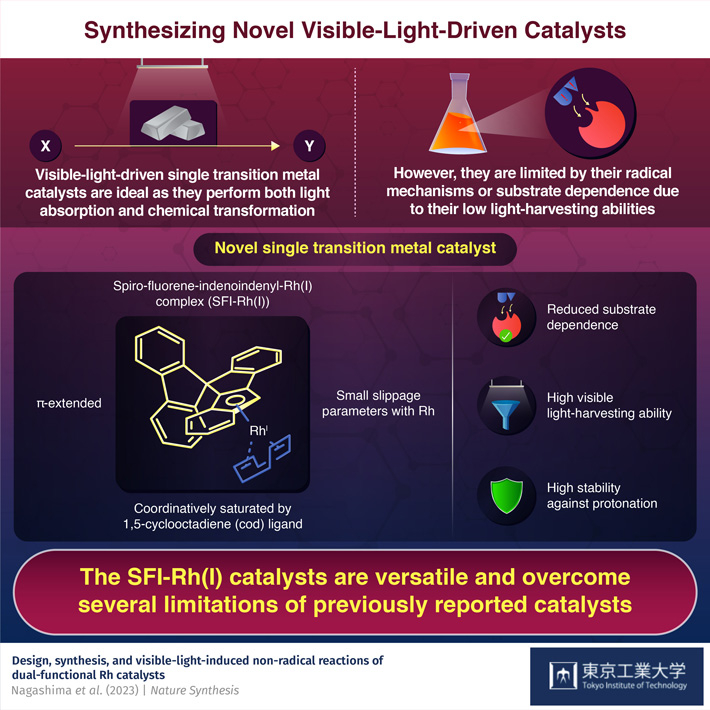Visible-light-driven single transition metal catalysts are ideal for photoreactions. Their potential has finally been fully harnessed by researchers from Tokyo Tech, who developed a catalyst with reduced substrate dependence and increased visible light-harvesting ability. This solves the limitations of previous catalysts, including their restricted applications, and opens up new avenues for photoreactions.

Photocatalysis is the use of light to accelerate the rate of a reaction in the presence of a photocatalyst. The catalyst plays a crucial role in this process—it absorbs the light being shined onto it and makes it available in way that can help accelerate the chemical reaction and also enhance it. These catalysts are used for a variety of light-dependent reactions ranging from the production of paper to the conversion of carbon dioxide to fuel. Given these applications, the development of ideal photocatalysts is important. An ideal photocatalyst is one that uses a single transition metal that which perform both visible light absorption and chemical transformation. Currently, visible light-driven single transition metal catalysts are limited to only one mechanism of operation, known as the radical mechanism, or have a low light-harvesting ability, making them heavily dependent on certain substrates. Thus, there is a need for an ideal single transition metal catalyst that solves these problems.
Fortunately, a team of researchers from Tokyo Institute of Technology (Tokyo Tech), led by Assistant Professor Yuki Nagashima, have reported a novel visible light-driven single transition metal catalyst that solves these issues. Their findings are published in Nature Synthesis. Dr. Nagashima explains, "We envisioned unprecedented rhodium (Rh)-based photocatalysts—spiro-fluorene-indenoindenyl (SFI)-Rh(I) complexes—that combine high light harvesting abilities with broad applicability."
The team found that extending the molecules around the central Rh atom—called the ligand—is necessary to increase the light harvesting abilities of these complexes, but also makes them less stable. Thus, the team designed SFI-Rh(I) complexes using a non-fused extension strategy, extending the molecules around the ligand without compromising the stability of the resultant catalyst. In fact, their extension strategy made the catalyst stable against protonation, and helped in increasing its light-harvesting ability, thus reducing its substrate dependence. The catalyst was also designed to be able to perform using multiple mechanisms, beyond the radical mechanism used by previous catalysts.
"The careful design of our catalyst enabled it to have many advantages compared to previously described catalysts, while making it suitable for complex reactions. The SFI-Rh(I) complexes can easily extend the scope of typical Rh-catalyzed reactions using blue light LED irradiation at room temperature. This," concludes Dr. Nagashima, "opens many avenues for future applications of these catalysts, as well as photocatalytic reactions in general. We believe that this catalyst has the potential to be a versatile light-driven catalyst that can break through the ground-state limitations in various photoreactions."
We look forward to seeing the many applications of their work!
Reference
Authors : |
Seiya Ouchi1, Tomonori Inoue1, Juntaro Nogami1, Yuki Nagashima1, and Ken Tanaka1
|
Title : |
Design, synthesis and visible-light-induced non-radical reactions of dual-functional Rh catalysts |
Journal : |
Nature Synthesis |
DOI : |
|
Affiliations : |
1Department of Chemical Science and Engineering, Tokyo Institute of Technology |






